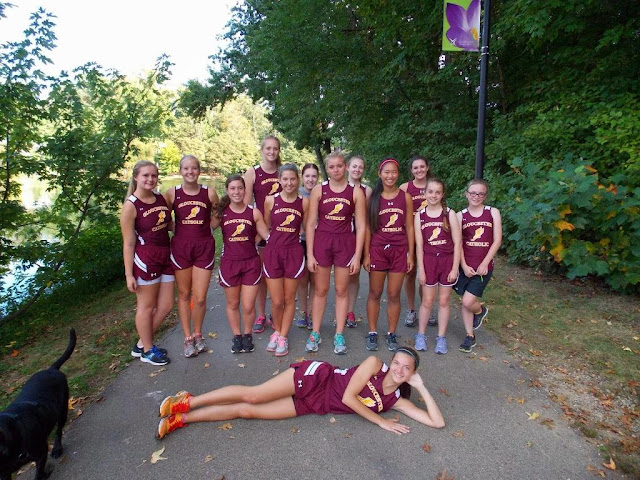The One Exercise That Just Might Change Your Running
Forever
The Huffington Post | By Sarah Klein
What
if all it took to improve your running immeasurably was a few minutes marching
in place?
In
a 2011 New York Times Magazine feature, Christopher McDougall, author of Born
to Run: A Hidden Tribe, Super Athletes and the Greatest Race the World Has
Never Seen experimented with just that."
I was leafing through the back of an out-of-print book, a collection of runners' biographies called 'The Five Kings of Distance,' when I came across a three-page essay from 1908 titled 'W. G. George's Own Account From the 100-Up Exercise,'" he writes. "According to legend, this single drill turned a 16 year old with almost no running experience into the foremost racer of his day."
I was leafing through the back of an out-of-print book, a collection of runners' biographies called 'The Five Kings of Distance,' when I came across a three-page essay from 1908 titled 'W. G. George's Own Account From the 100-Up Exercise,'" he writes. "According to legend, this single drill turned a 16 year old with almost no running experience into the foremost racer of his day."
Walter
Goodall George's earliest sporting interests were rugby and cycling, but he
went on to win over 1,000 amateur prizes and races and set long-standing
records as a professional runner. "He became unbeatable over the middle distances in an era before training became
scientific," the Oxford Dictionary Of National Biography
writes, all while pioneering his own personal brand of "scientific"
training, namely the 100-Up. In 1878, at age 19, he wrote a plan to break the
then-world record for the mile -- and proceeded to run nearly exactly his
plan's predicted time in 1886. In addition to his 100-Up essay cited by
McDougall, he also published a short book on the exercise in 1913, according to
the Oxford DNB.
 |
| Walter Goodall George in circa 1884. Credit: Getty Images |
George's 100-Up routine is divided into two parts, the minor
and the major. The minor involves standing with both feet about eight inches
apart "and your arms cocked in running position," McDougall writes.
Then, raise one knee at a time to hip height, bringing it back down lightly to its original position.
Then, raise one knee at a time to hip height, bringing it back down lightly to its original position.
The
major involves the same movement at a higher speed. McDougall quotes George:
"The body must be balanced on the ball of the foot, the heels being clear
of the ground and the head and body being tilted very slightly forward.... Now,
spring from the toe, bringing the knee to the level of the hip.... Repeat with
the other leg and continue raising and lowering the legs alternately. This
action is exactly that of running.”
Sounds
a little too simple, no?
Experienced
runners will likely recognize these movements as the tried-and-true running
drill commonly referred to as high knees, a simple way to up strength and endurance of the
hip flexor and quad, according to New York Road Runners (NYRR). Straightforward
as it looks, high knees --and other running drills -- can help you
become a better runner, says NYRR coach John Honercamp. The 100-Up is essentially exaggerated running
form, and performing 100 repetitions can help build muscle memory during a
similar state of fatigue that a runner might experience at the end of a tough
workout or a grueling race, he says.
 But
it's the focus on form that's most important. "You're reinforcing poor
form if you're doing it improperly," says Honerkamp. "Once you stop
doing it correctly, you shouldn't do it at all." That means concentrating
not just on returning each foot to its starting point, but paying attention to
arm swing, keeping the core stable and landing close to your center of gravity
on the balls of your feet every single time, he says. For most 100-Up
beginners, 100 reps is a long-term goal. Aim to start with maybe 20 repetitions
instead -- or however many you can complete with perfect form.
But
it's the focus on form that's most important. "You're reinforcing poor
form if you're doing it improperly," says Honerkamp. "Once you stop
doing it correctly, you shouldn't do it at all." That means concentrating
not just on returning each foot to its starting point, but paying attention to
arm swing, keeping the core stable and landing close to your center of gravity
on the balls of your feet every single time, he says. For most 100-Up
beginners, 100 reps is a long-term goal. Aim to start with maybe 20 repetitions
instead -- or however many you can complete with perfect form.
Don't
expect to see immediate results, either, Honerkamp warns. Running on your toes,
typically considered more efficient because you're spending less time on the
ground, may be the end goal, but heel strikers need to ease into adaptations.
"I worry about people trying to drastically change,” says Honerkamp.
"It's something to work on and think about, but don't over-think or
overcorrect," he says.
Whether
or not you devote yourself to the 100-Up for life or simply dabble in running
form drills periodically, incorporating focus on form into a warmup or regular
training routine is a good idea, says Honerkamp. “People skip [warmups] because
they're busy getting out of the door," he says, "but five minutes probably
will go a long way."
http://www.huffingtonpost.com/2014/06/04/100-up-running_n_5406664.html
Decades ago Dave Costill, the doc who studied runners at Ball State told me about reading George's book and his insistence that he owed his success to the 100 up.
So now I know what it is. I'm going to give it a try. Starting very, very gently at first."







.jpg)




.jpg)
.jpg)






























































.jpg)











